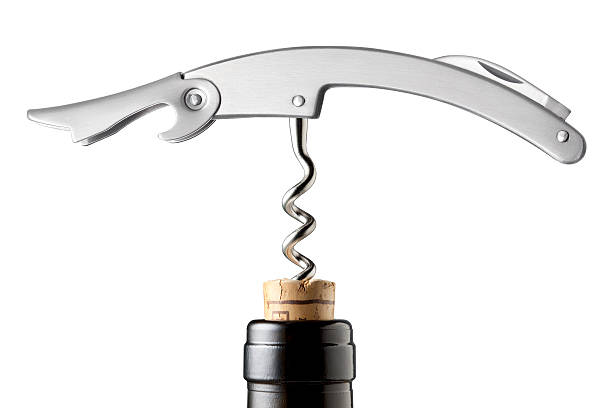How to use a wine opener
Watch our video before reading about wine openers to learn the correct way to use one.
There are many different types of wine openers.
Each type of corkscrew offers different benefits. They all open bottles of wine, but how they remove the corks varies. You may need multiple types of wine openers to remove other pins, depending on the wines you have. Here are eight types of corkscrews and how to use each one. This will help you decide which corkscrew you need.
- Wine Key
Most establishments use a Wine Key al, also known as a waiter’s corkscrew. These wine openers are the most popular because they combine affordability, functionality, and compactness. They’re also the oldest way to open a bottle of red or white wine. These are ideal for front-of-house use by servers who open and pour wines directly at the table. Some server’s wine corkscrews include a knife that can be used to cut the foil from a bottle of wine, as well as a bottle cap opener. They are also small enough to fit into the pockets of aprons for immediate, convenient use.
How to use a wine key:
Open a bottle of wine with a wine key by following the steps below.
- Cut the foil just below the lip of your bottle.
- Remove the foil from around the neck of the bottle.
- The worm will be inserted into the cork by twisting the corkscrew.
- The first small boot lever notch should be placed on the bottle lip and held in place.
- Pull the pin out about halfway by levering the handle.
- Pull the plug out the remainder of the way by moving the second boot lever to the tip.
- Reverse the corkscrew while holding the pin.
- Pocket Corkscrew
Corkscrews for pockets are compact and easy to carry in pants or aprons. Pocket corkscrews often come with a sheath that prevents the worm from piercing the fabric of the bag. The sheath can also be used to create a “T”-shaped crossbar to provide leverage for twisting the worm to the cork in order to remove it. These compact, portable corkscrews can be kept on hand by bartenders and servers. Pocket corkscrews may be smaller than traditional corkscrews but require greater manual strength to remove corks from wine bottles. They also do not usually include bottle openers.
How to use a pocket corkscrew
Open a wine bottle using a pocket corkscrew by following the steps listed below.
- Cut the foil just below the lip of your bottle.
- Remove the sheath from the corkscrew and slide it in the opening.
- Insert the corkscrew in the cork, and then turn it until the worm has been inserted.
- Pull the handle outwards once the worm has been fully inserted to remove the pin.
- Reverse the corkscrew while holding the plug.
- Wing Corkscrew
Wing or winged corkscrews feature two levers that are on opposite sides. They raise when the worm is twisted into the cork, and then they are pushed to remove it. These are popular for removing synthetic corks due to their simplicity. They can also be used with pins of any size, which adds to their versatility. Wing corkscrews should not be used to open vintage wines or wines that have natural corks. They can leave behind cork crumbs. These corkscrews have a compact size and an easy-to-use design. They are perfect for servers to use in the front of the house.
How to use a wing corkscrew
Open a wine with a wing corkscrew by following the steps listed below.
- Cut the foil just below the lip of your bottle.
- The foil should be cut around the neck.
- Insert the worm in the middle of the cork after removing the foil.
- The worm will be inserted into the pin by turning the lever. Continue to twist until all of the wings are raised.
- Push down simultaneously on the wings to remove the plug from the bottle.
- Turn the handle in the opposite direction to pull the plug.
- Electric Corkscrew
The easiest way to open a wine bottle is with Electric corkscrews. The simple push-button design makes it easy for anyone to open wine bottles. These corkscrews can be used in the back of the house to open bottles of wine quickly. Electric corkscrews can be used by beginners, people with carpal tunnel or arthritis, and those who have limited hand mobility. Electric corkscrews, because they are bulky and large, are not ideal for table service. Uncorking wine, which is a big part of the enjoyment, can be just as important as drinking the wine. Keep it charged to ensure it’s always ready for use.
How to use an electric corkscrew
Open a bottle of wine with an electric opener by following the steps listed below.
- Cut the foil just below the lip of your bottle.
- Place the electric corkscrew atop the neck of the bottle. Keep the corkscrew upright.
- When you turn the corkscrew, it will automatically insert a worm to remove the cork.
- Once the corkscrew removes the pin, remove the corkscrew.
- Remove the plug by reversing the motion of the corkscrew.
- Mounted Wine Opening
Mounted Wine Openers are mounted on a beam wall or can be attached to the countertop. Mounted corkscrews for wine openers offer more torque and open bottles with less effort. The wall-mounting corkscrew has different depths of penetration. It is ideal for partial cork removal at banquets, where wine will be served on tables prior to the event. Some corkscrews have a more upscale look that can be used in high-volume environments.
How to use a mounted wine opener:
Open a wine with a mounted screwdriver by following the steps listed below.
- Insert the neck of the bottle into the cradle.
- Insert the corkscrew by pulling down the handle.
- Pull the cork by returning the handle to its original position.
- The pin will drop to the ground once the bottle has been removed from its cradle.
- Lever Corkscrew
The lever corkscrews are gaining in popularity due to their ease of operation. The majority of lever corkscrews require only two movements: a forward motion to insert the worm into the cork followed by a gentle pull out of the pin. Lever corkscrews are great for controlling the corkscrew as they hold the bottle neck firmly while in use. They are also great for people with arthritis, carpal tunnel syndrome, or limited hand mobility. The lever corkscrews are great for removing older corks, but they’re not recommended to extract synthetic corks.
How to use a lever corkscrew
Open a wine bottle using a lever corkscrew by following the steps listed below.
- Remove the foil from around the neck of the bottle.
- Place the corkscrew lever up on top of the bottle.
- Insert the worm by pushing the lever downward.
- Pull the handle up once the lever has been lowered to remove the cork.
- Lift the corkscrew from the bottle, and then flip the handle up and down a few times.
- Wine Cork Extraction
Wine Cork Extractors have prongs that slide between the wine glass and the cork in order to remove it. Wine cork extractors require more strength than other corkscrews to pull the pin. These are best used with vintage pins that are made of natural cork. The extractors won’t cause vintage pins to be damaged or to fall apart, dropping crumbs in the wine. This allows you to reseal your bottle after you finish pouring. These extractors can be kept behind the bar or even in aprons for easy access.
How to use a wine cork extractor:
Open a bottle of wine with a cork extractor by following the steps listed below.
- Cut the foil just below the bottle’s lip.
- Holding the bottle tightly, slide the extractor’s prongs in between the corks and the inside of its neck.
- Apply light pressure to the handle while swaying the prongs from left to right.
- Twist the extractor once fully inserted and then pull upward to remove the cork.
- Slide the pin out of the extractor by sliding it between the prongs.
- The Continuous Pull Corkscrew
The continuous pull corkscrews are usually two-pieces and use a twisting motion to drive the worm in the cork. Many styles feature hinges on their handles that allow you to squeeze the handle around the neck of the glass bottle for a better grip. These corkscrews, which are small and easy to use, are perfect for servers and bartenders.




